(You can also find this post on our Kickstarter update page)
Lots of work on the OBD-II classic adapter. Here’s information on the progress and how it works
How it works
The OBD-II classic adapter (code named OBD2CAN) makes cars with older OBD-II protocols appear as if they had modern CAN bus OBD-II, by acting as a bridge between the two protocols. While providing compatibility with modern protocols, it will not do anything magical – specifically, it will not make the older OBD-II protocol faster, nor will it expose any additional channels. So if you have an E36 BMW with its legendarily crappy OBD-II performance, it won’t get any better. Sorry. 🙂
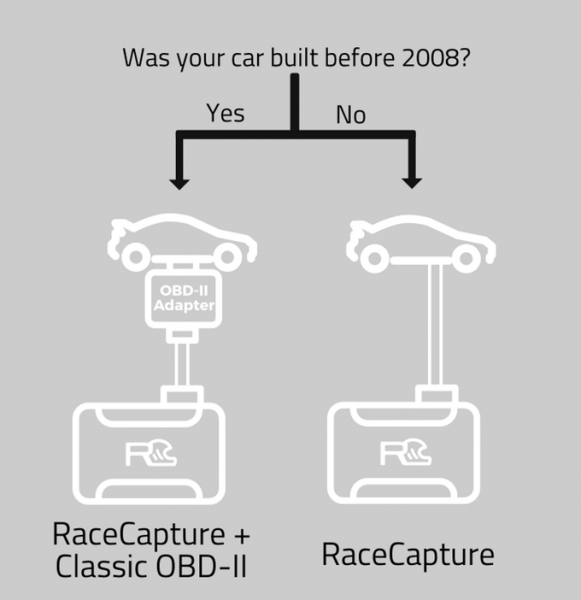
So why do it? There are many OBD-II compatible pieces of hardware that only support CAN bus, including our own RaceCapture/Pro and the new RaceCapture recently funded on Kickstarter . Supporting just CAN OBD-II is simple, effective and all cars since 2008 (plus select cars as early as 2004) support CAN. So, our OBD2CAN adapter will transparently bridge older protocols and make it possible for CAN-only systems to work with older cars.
Natively supporting all of the older OBD-II protocols in a product adds considerable complexity and cost, which affects testing, manufacturability and price to support a capability that is increasingly not needed as new car models are introduced. So, if an installation needs older OBD-II support, an external bridge/helper module is the best option.
Some technical details
The OBD2CAN bridge uses the proven and robust STN1110 protocol chip and reference design to provide the OBD-II interface for all legislated legacy OBD-II protocols:
- ISO 14230-4 (Keyword Protocol 2000)
- ISO 9141-2 (Asian, European, Chrysler vehicles)
- SAE J1850 VPW (GM vehicles)
- SAE J1850 PWM (Ford vehicles)
Using the STN1110 saves tremendous time and leverages all of the work dealing with the many OBD-II quirks and protocol variances.
On the CAN side, we use the lightweight STM32F072 as the CAN front end and translator to the STN1110’s ELM327 compatible protocol. The behavior will be dead-nuts simple: receive a PID request on CAN, then forward to STN1110; receive PID data from STN1110 and reply on CAN bus. Downstream systems will simply think they’re talking to a CAN-enabled OBD-II vehicle.
Testing the power supply
To work with all of the legacy OBD-II protocols, the OBD2CAN bridge needs 5.7, 7.4, 5 and 3.3v internal power supplies. Lots of hand soldering and tweezer work needed for this part of the assembly – always a reminder of how efficient the pick and place machine is. Fortunately our test unit passes the smoke test!
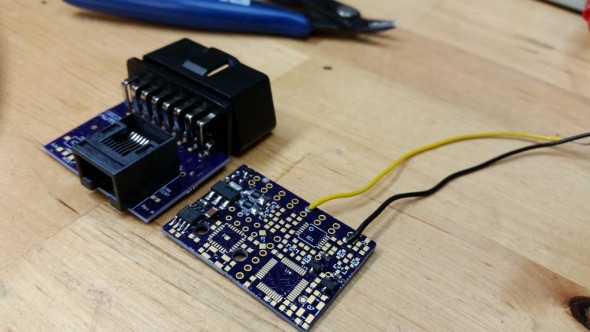
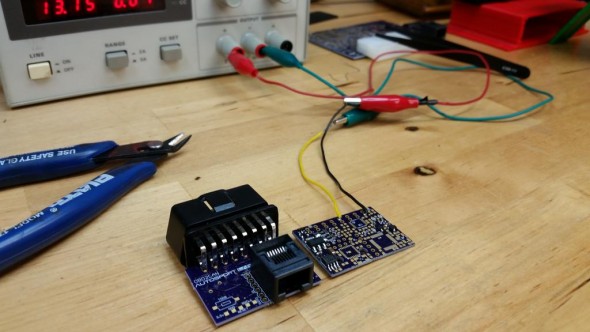
Remaining components
The remaining components implement support for the legacy OBD-II protocols (STN1110 and support components) and the STM32 for the CAN front-end.
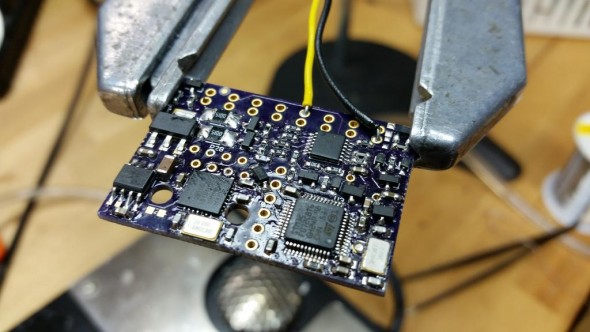
Next step is to solder the male OBD-II plug and the downstream RJ45 plug onto the board:
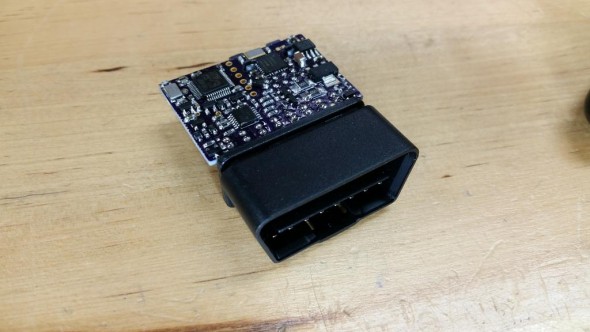
An atypical design for us; mounting connectors on the bottom size. The tight packaging of the enclosure demands it this time!
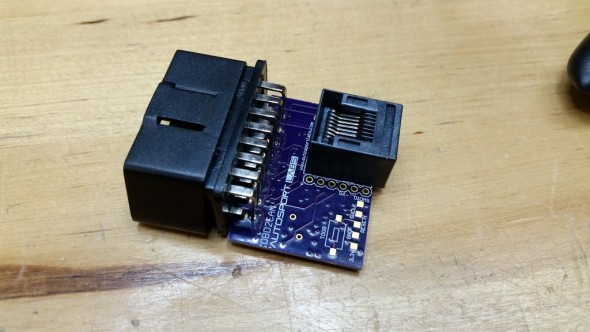
Test fitting enclosure
The enclosure will need milling to fit the end connector ; in the meantime, we’ll hand nibble it out as carefully as possible.
The end result: not bad. Still needs some fine tuning on the PCB fitment (it’s a little tight)
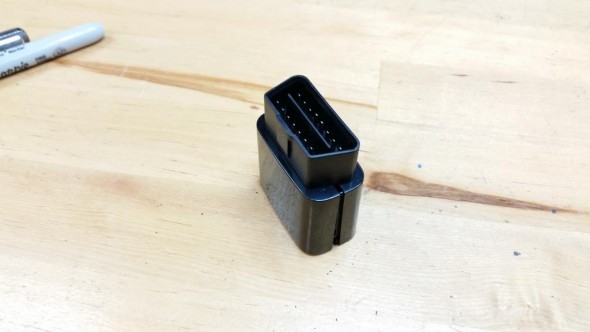
Integration with RaceCapture and RaceCapture/Pro
Here’s an example of it integrated with RaceCapture/Pro MK2 – fitting in-line with the system. Same idea with the new plug and play RaceCapture !
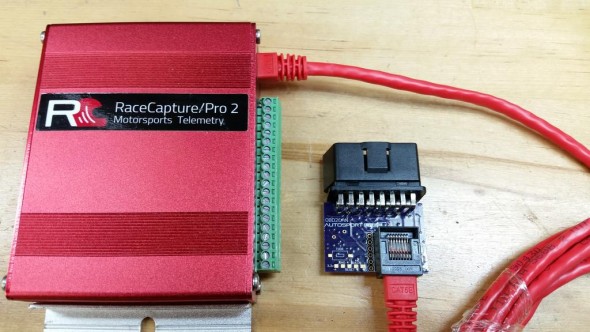
Next Steps
Next steps is to get the firmware written to bridge the two worlds together and get it working with the OBD-II protocol simulator. For initial bench testing and firmware development the ECUSIM 5100 is a good alternative to running between a row of older cars – and it fits just a bit better on the benchtop.
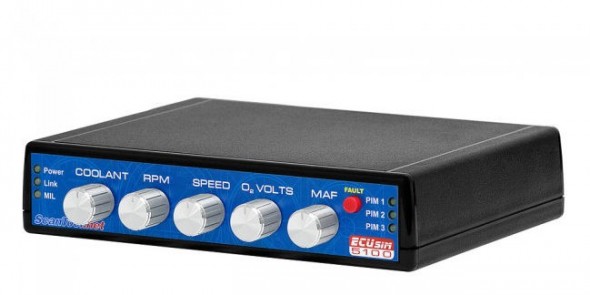
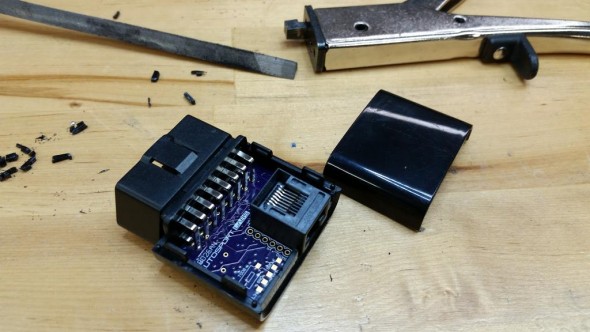
Looks like you’re getting close to release on this. When will the RaceCapture Pro adapter be for sale?
Indeed we grow closer. Unfortunately no release date just yet…. Gotta get it done right before we can sell it :D.
I understand what it takes to test and validate a new product, especially with as many projects as you guys have going right now. I’m building a factory five 818R with a 2007 wrx engine and ecu. There won’t be any analog gages, just RCP connected to a small pc and a display. Getting the info directly from the ecu is a necessity, there are some DIY solutions I’ve seen using an arduino but if you guys are getting close I’d rather use it. Is it weeks, months or years away from release? I’d be willing to beta test a preproduction unit. My car won’t hit the track until next season so I’m not really in a rush for a solution.
Hi Daniel,
Understood. Possibly the best bet in the short term is a RaceCapture/Pro; you can wire in a mix of direct sensors (like RPM, which is a 1 wire connection) and extra OBD-II sensors later, when that adapter becomes available.
Thanks!
I’ve seen that some of the beta testers are running these now. When will it be available? Specifically for the 2007 wrx ecu.
Hi Daniel – indeed they are. We have to do a minor hardware revision before we go into regular production – more details in our Kickstarter update: https://www.kickstarter.com/projects/autosportlabs/racecapture-and-podium-race-it-share-it-prove-it/posts/1756911
It is a high priority for us, but no firm time estimates. Watch the blog and our social media outlets for news. Thanks!
Any update on a release date?
Yep, working on the next batch of inventory over the next couple of weeks. Watch for updates here!